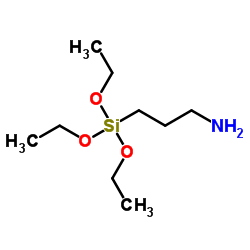We serve (3-Aminopropyl)triethoxysilane CAS:919-30-2 to global customers since 2007, Pls send inquiry to info@nbinno.com or visit www.nbinno.com our official website should you have any interests. This site is for information only.

Chemical Name:(3-Aminopropyl)triethoxysilane
CAS.NO:919-30-2
Synonyms:1-Propanamine, 3-(triethoxysilyl)-; 3-Aminopropyltriethoxysilane;
Molecular Formula:C9H23NO3Si
Molecular Weight:221.36900
Physical and Chemical Properties:
Density:0.946;
Melting point:-70oC;
Boiling point:217oC;
Flash point:96oC;
Index of Refraction:1.422;
Specification:
Appearance:Colorless transparent liquid
Purity(GC):≥99.0%
Packing:190 kg/drum, can also be packaged according to customer requirements
Storage:Store in a cool, ventilated place
Application:Silane coupling agent it is applied in plastic products(including cables, glassfiber-reinforcement plastics etc.), rubber products, adhesives, coatings, pigments dispersion, inks, magnetic materials (plastic magnet and rubber magnet), metallic casting resins and resins concrete, etc.
It maximizes the physical and electrical properties of mineral-filled phenolics, epoxies, polyamides, polybutylene terephthalate, and a host of other thermoset and thermoplastic composites. Filler wetting and dispersibility in the polymer matrix are also improved.
It improves adhesion between magnetic powder and organic resins and dispersion of magnetic powder inorganic resins.
Also these magnetic appliances attain higher magnetic orientation and excellent magnetic properties, higher mechanical strength, good processability, excellent weathering resistance.
In glass-reinforced thermoset plastics, it enhances the flexural, compressive, and interlaminar shear strengths before and after exposure to humidity. It greatly improves wet electrical properties.
With nitrile, polysulfide, expoxy, urethane, and adhesives and sealants, it improves pigment dispersion and maximizes adhesion to glass, aluminum, and steel.
When it is used, glass-reinforced thermoplastics, polyamides, polyesters, and polycarbonates exhibit increased flexural and tensile strengths before and after wet exposure.
In glass fiber and mineral wool insulation, as a phenolics resin binder additive, it imparts moisture resistance and allows recovery after compression.
In shell molding foundry applications,it strengthens the bond between the phenolics binder and foundry sand.
In grinding wheels, it promotes an improved, water-resistant bond between the abrasive grit and phenolics resin binder.
It is an excellent adhesion prompter in urethane, epoxy, and acrylic latex coatings, adhesives, and sealants.
Contact us for information like (3-Aminopropyl)triethoxysilane chemical properties,Structure,melting point,boiling point,density,molecular formula,molecular weight,3-Aminopropyltriethoxysilane physical properties,toxicity information,customs codes,safety, risk, hazard and MSDS, CAS,cas number,3-Aminopropyltriethoxysilane Use and application,(3-Aminopropyl)triethoxysilane technical grade,usp/ep/jp grade.
Related News: Italy and Vietnam included Taiwan in banning flights from China, a move that they announced after the W.H.O. declared the coronavirus outbreak a global health emergency.3,4-Difluorobenzoic acid manufacturer As United Airlines said when suspended flights to Beijing, Shanghai and Chengdu, the decision was made “due to the continued drop in demand for travel to China and the US Department of State’s decision to raise its China travel advisory to a Level 4.”1-Cyclopropyl-6,7-difluoro-1,4-dihydro-8-methoxy-4-oxo-3-quinolinecarboxylic Acid Ethyl Ester supplier Madeleine Roche, Associate Pharmaceutical Analyst at GlobalData, comments: “Within the top 20 global companies that spent the most on R&D in 2018, the top spender – despite having the second smallest annual revenue of the group at $15.28 billion – is Celgene, whose R&D spend was equal to 37% of its annual revenue.2-methyl-3-[(2-methylfuran-3-yl)disulfanyl]furan vendor Developing countries such as China and India have good foundations for undertaking global industrial transfers because of their comparative advantages. With the continuous improvement of China’s fine chemical technology level, the types of products and market shares in China’s undertaking industrial transfer have gradually increased.FT819 is derived from a clonal master engineered induced pluripotent stem cell (iPSC) line with complete elimination of T-cell receptor (TCR) expression and a novel 1XX CAR targeting CD19 inserted into the T-cell receptor alpha constant (TRAC) locus.

